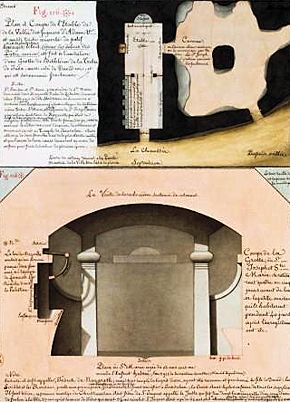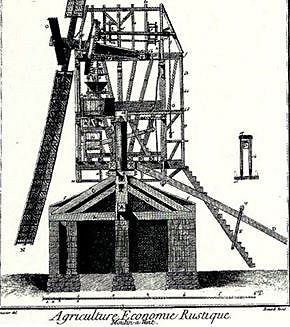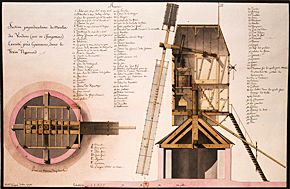Lequeu at Bibliotèque nationale de France
Architecture Civile 3781 b c d
Emil Kaufmann, Three Revolutionary Architects--Boullée, Ledoux and Lequeu (1952).
Emil Kaufmann, Architecture in the Age of Reason: Baroque and Post-Baroque in England, Italy, and France (1955).
The division between clear perception and confused perception sees lined up on one side Boullée, Durand, Dubut, Schinkel and, later Garnier, Loos, Le Corbusier, Gropius, European Constructivism, Louis Kahn; on the other Lequeu, Romantic and Expressionist movements, and, then, Dada, Action-Painting, Pop Art and the architectural neo-eclectic and neo-expressionist movements.
Manfredo Tafuri, Theories and History of Architecture (1976), pp.82-4.

J. J. Lequeu, The stable in the Valley of Adam's Figtrees; Place where Mary, twelve years old, gave birth to the Hebrew Child.
Thus Lequeu seems always to have worked on the fringe of public institutions: first at the free school of drawing in Rouen, a marginal offshoot of the local Academic Royale; then in Souffiot's office at Sainte-Genevieve, slightly apart from the Academic Royale d'Architecture; then as a marginal employee in the new institutions which were created to answer the needs of the Revolution. On retirement in 1815, Lequeu offered a challenge to 'les mondains' [The men of the world]--the technocrats and official experts such as Rondelet, Chaptal, Prony, Denon and Bruyere, as well as the leading ordonnateurs, the architects Leroy, Ledoux, Boullee, Heurtier, Dufourny, Percier, Peyre and others. This challenge took the form of drawing, which was his only weapon. He declared (in one of his advertisements, published in English): 'I shall now fly the company of men from whom he has received nothing but injustice and ingratitude: I shall go, and I defy the others'--and he repeated several times in French, 'je fuirai la compagnie des hommes, n'ayant reçu de plusieurs que des injustices et des ingratitudes, je vais me défier des autres'.
| |
The ground for Lequeu's defiance was the subculture which he had made his own, that of the almanacs and popular literature, the comedy of the incongruous, the ill-assorted, the 'heteroclite'. The kind of laughter provoked by Lequeu's encyclopaedic work makes us classify it with that 'certain Chinese encyclopaedia' mentioned by Michel Foucault:
It left a suspicion that there is no worse disorder than the incongruous and the linking of things that do not belong together . . . this would be a disorder which sets aglitter the facets of many possible orders of things in the no-man's-land of the 'heteroclite' which has neither laws nor geometry; and we must take this term in its etymological sense as meaning things that are so placed, 'laid down' or disposed that they have no slot or pattern into which they naturally fit, and no common place or ground underlying them. Utopias are reassuring, because although they have no place in reality they open up cities with vast avenues, admirably designed parks, landscapes of milk and honey, even though our access to them is chimerical. But heterotopias are disturbing, no doubt because they furtively undermine language, because they prevent us from naming this or that; because they destroy or confuse names; because they set out to corrupt or demolish 'syntax'--not only that syntax which structures phrases, but that less obvious one which binds words and things together, side by side and face to face. That is why utopias allow the creation of fables and discourses, confabulations which are the direct outcome of the spoken language itself in its natural dimension of the fabula; whereas heterotopias inhibit expression, halt words in their tracks, threaten the very existence of a unifying grammar: they dismember our myths and strike barren the lyricism of fine words. [from "Preface", The Order of Things]
Surprisingly, Lequeu's work appears as a deliberate illustration of the definition and classification of architecture included by d'Alembert in his detailed account of the system of human knowledge for the 1751 Encyclopédie:
The classification of the departments of human knowledge into History, which is related to Memory; Philosophy, which derives from Reason; and Poetry, which is the product of Imagination .... History treats of human beings who really exist or who have existed; and Poetry treats of human beings imagined on the model of historical beings .... Here we mean by Poetry only that which is Fiction .... We shall relate Architecture, Music, Painting, Sculpture, Engraving, etc., to Poetry .... As for the Architect, he imitates Nature only imperfectly through the symmetry of his works .... Poetry has its monsters, even as Nature has: one must include among them all the products of the disordered imagination, and such works may exist in every genre.
Inasmuch as it is fiction, Lequeu's work, which at first sight appears to be the product of a disordered imagination, finds its place within 'a certain Chinese encyclopaedia'. It is Lequeu's monstrous achievement that he constructs a space in which encyclopaedic listing, carried to excess, ruins classical representation. His game is a deadly Aunt Sally, a jeu de massacre.
2 TROPOLOGICAL SPACE
The remarkable capacity of language for being rich even in its poverty was well known to eighteenth-century grammarians. In their purely empirical conceptions of the sign, they were struck by the way in which a word may divorce itself from the visible form with which it is associated by its signification, and then attach itself to a different one, designating it with an ambiguity which is both a limitation and a resource. In behaving this way, language is discovering the origins of its own inner movement. Its relationship to what it says may change without its form also changing, as if it were rotating upon itself, tracing round a single focus a whole circle of possibilities (the 'sense' of the word as they called it in those days) and allowing for accidents, encounters and effects and all the more or less concerted efforts of the game. According to Dumarsais, one of the subtlest of those grammarians, it was absolutely necessary to make the same words serve for different purposes. It was noted that this admirable expedient could add to the vigour and grace of discourse, and it naturally developed into a game or entertainment. So by chance and by choice, words are often diverted from their original meaning to assume another meaning which is more or less remote from it, while still bearing some relationship to it. This new meaning of words is known as its tropological sense, and the conversion or semantic shift producing it is called a trope. All the figures of rhetoric are created through this kind of displacement of meaning (what Dumarsais called 'turns' and 'deviations'): catachresis, metonymy, metalepsis, synecdoche, antonomasia, litotes, metaphor, hypallage, and many other hieroglyphs traced by the rotation of words within the linguistic mass.
Michel Foucault [Death and the Labyrinth]
| |
Jean Jacques Lequeu, the skilled draughtsman, assumes his place in history just before, during and after the Revolution which marked the establishment of our bourgeois and capitalist society. His crude and indeed obscene testimony throws a new light on the social division of labour during that period of transition. His picturesque writings make us aware of such ideological organizations in the background as the Encyclopédie, the free school of drawing in Rouen, the provincial academy, the masonic lodges, the Ecole Polytechnique, the land registry and the office of public buildings. In the Encyclopédie the famous architect and teacher Jacques François Blondel gives a precise description of Lequeu's trade:
Architectural Drawing: a geometrical or perspective representation, on paper, of a given project. Line drawing - a diagram in pencil or ink, without shading. Washdrawing--one in which shading is marked in Indian ink. A finished or final drawing is one which is approved for execution, and on which the contract is based and signed by contractor and client. Drawing has to be recognized as the skill most vital to the architect, making clear which forms are most appropriate for the several parts of an edifice, while observing the principles of harmony. Without draughtsmanship the most fertile and inventive genius will find his work frustrated, while the need for some of the best architects to depend upon another man's hand to convey their ideas all too often results in a loss of vitality or the production of a collection of disparate features, all of which might be worthy enough in themselves but which, not having been drawn by the architect himself, together amount to nothing more than an ill-matched miscellany. Drawing is not only a matter for the architect, as in general it includes the human figure, ornamentation, civil and military architecture, etc. For this reason it is no exaggeration to say that it should form part of every kind of education: for men of genius or talent, in order to acquire Taste, of which the essence is in drawing or design; for men of gentle birth, for their personal satisfaction; and for artisans, to enable them to progress and more rapidly achieve distinction in their calling.
Descamps' free school of drawing in Rouen aimed to 'provide free instruction for working men and for children without means', in accordance with Diderot's advocacy in the Encyclopédie of training artisans, or 'working men engaged in those mechanical arts which demand the least intelligence', to become artists, 'as we call tradesmen who excel in those of the mechanical arts which demand intelligence'. Such was the case with Lequeu, who 'in order to progress and more rapidly achieve distinction', became an architectural draughtsman:
An architectural draughtsman is one who designs, draws, and completes the plans, sections and elevations of buildings, according to the measurements taken or provided. To qualify for this title it is not enough to know how to layout a plan and produce a working copy. It is important not only to be able to draw buildings competently but to have a more than superficial knowledge of sculpture, painting, perspective and chiaroscuro: this accomplishment is by no means common. The fact is that these studies, which are indispensable for the training of an efficient draughtsman, require several years of application. It is unusual for men of means to make the effort of overcoming their distaste for such protracted studies; while the impecunious are often discouraged by their private circumstances from completing their instruction. These two main reasons explain why we have so few skilled draughtsmen in France. Most of them jib at life-drawing and ornamental design, in the belief that these are the province of painters and sculptors: but it is surely impossible to draw an ordinary plan, which constantly entails curves, involving taste; or to plot a series of steps or a winding staircase; or to vary the forms of a room or of a profile; unless by long practice in draughtsmanship one has mastered the great variety of forms that are present in Nature. If a man who is called on to layout architectural plans must also have a grasp of the human figure and ornamentation, what degree of talent must we not demand of one who is to interpret the thoughts of a gifted architect, whose draughtsman he is? Can he be relied upon to supervise a decoration? What reports and accounts can he provide of the execution of the carpentry, metalwork, sculpting, gilding and the like? How, in a word, is he to equip himself for greater responsibilities, if he has not spent many of his early years earnestly toiling under the guidance of a skilled master, and if he fails to combine theory and practice, and if he is not endowed with those natural gifts and inclinations which will enable him to bring fire, genius and invention to everything that he produces?
| |
Such was the definition of Jean Jacques Lequeu's professional work provided by Blondel in the Encyclopédie of 1751. It was plainly in defiance of the Encyclopédie, but also with its aid, that Lequeu began to produce drawings and attendant inscriptions based on free association: this is the very technique of cross-referencing, the renvoi, which was dear to Diderot's heart. Lequeu's undertaking was formulated by Diderot himself under the rubric Encyclopédie:
To bring together the knowledge scattered over the earth; to expound its general system to those among whom we now live, and transmit it to future generations, so that the labours of past ages shall not have been in vain for the ages to come; that our descendants, as they become better informed, may at the same time become happier and more virtuous; and that we may not die without having deserved well of mankind.
Aware of the dangers in the immense mass of material in any encyclopaedia, Diderot asked:
How can anyone man, in the short span of his existence, ever succeed in knowing and extending the universal system of Art and Nature? . . . I do not believe that it can be given to anyone man to know all things, or to see all that is to be seen, or to understand all that is to be understood . . . A universal, logical and systematic dictionary of the Sciences and Arts can therefore not be the work of one man alone.
This is the challenge which Lequeu, alone, endeavoured to meet, pitting his wits against the very source of his own alienation in society, the Encyclopédie itself. He sets out to be 'the writer who would endow his work with timeless charm', and who in doing so, as Diderot added,
can never be too wary of allowing his style to be influenced by the ephemeral ideas of his day, or by current opinion, or by accepted systems and passing fashions in the arts: all such models are only temporary manifestations, and he should, rather, favour the phenomena of the elements, the spectacle of the universe and the passions of mankind, which never change; then the truth, force and inimitability of his palette will be such that his works will remain a source of wonderment from age to age, despite any lack of order in his themes, any absurdity in his views, and whatever faults may be found in his productions. His personal ideas, comparisons and metaphors and turns of phrase, his images which always refer back to Nature, which we can never weary of admiring, will be truths enough, however partial, to ensure his survival.
As regards architecture Diderot adds, more specifically, that
it is not possible, even for the most fertile architect of genius, to introduce as much variety into the design of a great building--by combining the different orders and integrating all its parts into a unity--as may be achieved in encyclopaedic order.
This 'encyclopaedic order', the overall plan adopted by Lequeu in his role of 'architect of genius', corresponds exactly to Diderot's image of a 'vast avenue stretching into the distance, along whose length others equally well laid out will appear, all leading to remote but unique objects by the easiest and shortest way'. This was Diderot's own ideal:
Creating an encyclopaedia is like constructing a great city. The houses should not all be designed on the same model, even if one had invented a universal pattern beautiful in itself and suitable for any site. Uniform buildings resulting in uniform thoroughfares would give the whole city a dismal and wearisome appearance. Pedestrians are quickly depressed by a long wall, and soon tire even of a forest which has delighted them at the outset.
| |

Windmill, plate from the Encyclopédie of Diderot and d'Alembert, 1751-72

J.J. Lequeu, Vertical section oj the Mill at Les Verdiers...
'La section perpendiculaire du Moulin des Verdiers (avec ses changemens) exécuté près Guiseniers, dans le Vexin Normand' [Vertical section of the Mill at Les Verdiers (with his changes) executed near Guiseniers, in the Vex in, Normandy], which was drawn by Lequeu in 1778, is one of his most obvious borrowings from the plates of the Encyclopédie, those illustrating the windmill. Apart from the fact that he restores this mill to its original location in the Andelys region of the Eure department (not indicated in the Encyclopédie), Lequeu adapts to his own drawing the key captions corresponding to the letters and numerals of the first four plates in the Encyclopédie's series of 'Windmills and Watermills in Agriculture and Rural Economy', but with some 'changemens' which he calls 'renvois' or cross-references. In so doing Lequeu was choosing 'the most important part of
encyclopaedic order', the cross-reference, as his hobby-horse for tilting against the Encylopaedists.
|


